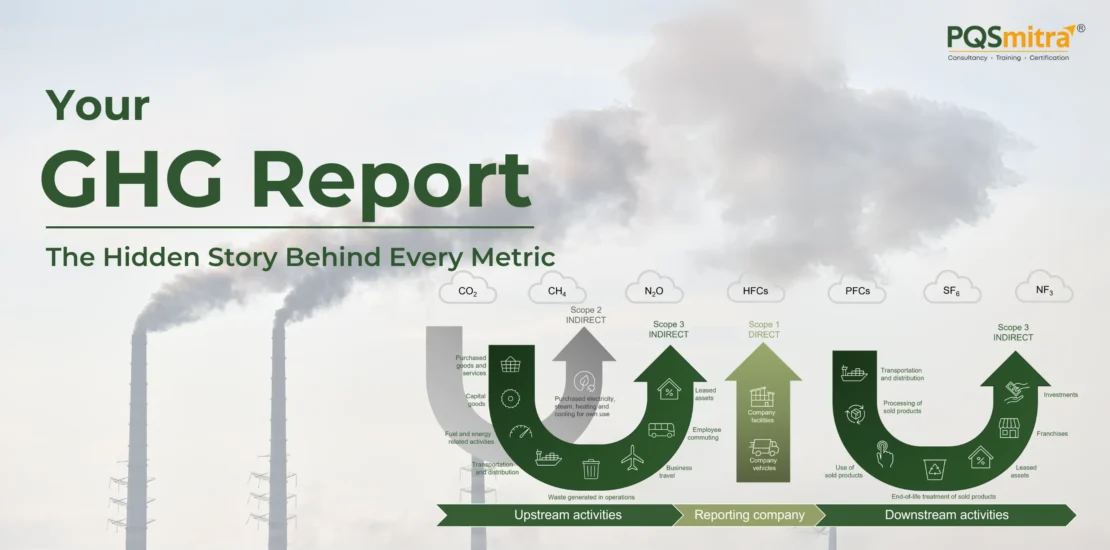Your GHG Report: The Hidden Story Behind Every Metric
- May 12, 2025
- Posted by: PQS_Mitra_Main_Access
- Category: Environmental Social and Governance (ESG)

Ever looked at your company’s greenhouse gas (GHG) report and wondered—what’s the bigger picture? Beyond the numbers, these reports tell a fascinating story about your business’s sustainability journey, operational efficiency, and even future risks. But are you reading it right? Let’s break it down in a way that makes sense.
Beyond Compliance: What Your GHG Report Says About You
Most organizations track their emissions because regulations or stakeholders demand it. But a GHG report is more than just a compliance document—it’s a mirror reflecting your company’s environmental footprint, supply chain decisions, and overall sustainability strategy.
Take a closer look, and you’ll find insights hiding in plain sight.
Scope 1 (Direct Emissions) – Your Operational Footprint
These are emissions from sources you own or control—fuel combustion in company vehicles, on-site energy use, and industrial processes. A high Scope 1 footprint often signals reliance on fossil fuels, outdated equipment, or inefficient energy practices. If your company is serious about sustainability, reducing Scope 1 should be a priority through energy-efficient upgrades, fleet electrification, and operational optimization.
Scope 2 (Indirect Emissions from Purchased Energy) – The Power Factor
Scope 2 emissions come from the electricity, heating, or cooling your business purchases. If your electricity still comes from a coal-heavy grid, your carbon footprint remains high, even if you don’t burn fossil fuels directly. Investing in renewable energy sources, green power purchase agreements (PPAs), or energy-efficient systems can drastically lower these emissions.
Scope 3 (Supply Chain & Business Activities) – The Silent Culprit
Here’s where it gets tricky. Scope 3 covers everything else—emissions from suppliers, transportation, business travel, waste disposal, and even how your products are used and disposed of. Since Scope 3 emissions often account for more than 80% of a company’s total carbon footprint, reducing them means working closely with suppliers, optimizing logistics, and improving product sustainability.
The Hidden Red Flags in GHG Reports
Companies often miss subtle warning signs buried in their reports. Here’s what you should be looking for:
Unexpected Increases in Emissions – If your carbon footprint is creeping up year after year, it could indicate operational inefficiencies, lack of clean energy investment, or supply chain issues that need urgent attention.
Disproportionate Scope 3 Emissions – If most of your emissions come from Scope 3, it’s a clear sign that your suppliers, distribution network, or product lifecycle need optimization.
Energy Source Mismatch – Does your sustainability messaging align with your actual energy consumption? If you claim to be a “green business” but still rely on fossil-fuel-based electricity, investors and customers might see this as greenwashing.
Over-Reliance on Carbon Offsets – Are you truly reducing emissions or just buying offsets to maintain a green image? While carbon offsets play a role, they shouldn’t replace genuine reduction efforts.
How PQSmitra Helps You Decode & Improve Your GHG Report
Understanding your GHG report is one thing—taking meaningful action is another. This is where PQSmitra steps in as your trusted GHG reporting consultant.
PQSmitra provides end-to-end GHG reporting services, ensuring businesses accurately track, analyze, and improve their emissions data. From identifying emission hotspots and ensuring compliance with global standards to helping set science-based reduction targets, PQSmitra translates carbon data into actionable strategies. Whether it’s working with suppliers to reduce Scope 3 emissions, adopting renewable energy solutions, or implementing decarbonization initiatives, PQSmitra equips businesses with the insights and tools needed to thrive in a low-carbon economy.
By partnering with PQSmitra, businesses not only meet regulatory requirements but also turn their GHG reports into a strategic advantage for long-term sustainability.
Turning Insights into Action: What to Do Next
Now that we’ve uncovered what your GHG numbers are really saying, here are some practical steps to improve your sustainability strategy:
- Set Science-Based Targets (SBTs)
Instead of unclear sustainability goals, align your emissions reduction targets with the Science-Based Targets initiative (SBTi). This ensures your business stays on track with global climate goals and investor expectations.
- Engage Suppliers in Carbon Reduction
Since Scope 3 is often the biggest contributor to emissions, work closely with suppliers to reduce their footprint. Choose partners that prioritize low-carbon manufacturing, sustainable logistics, and green materials.
- Switch to Renewable Energy
Lowering Scope 2 emissions is as simple as transitioning to solar, wind, or hydro energy. Many businesses opt for green power purchase agreements (PPAs) to secure clean electricity at stable prices.
- Optimize Transportation & Logistics
If your company relies on logistics, switching to electric vehicles (EVs), optimizing delivery routes, and using fuel-efficient transport can significantly lower emissions.
- Conduct Internal Carbon Audits
Regular carbon audits help identify areas where emissions can be cut. GHG reporting consultants provide customized carbon reduction strategies to optimize energy use and minimize waste.
- Improve Circular Economy Practices
Reduce emissions by rethinking waste disposal, recycling materials, and designing products with sustainability in mind. A circular economy approach cuts down both Scope 3 emissions and long-term costs.
The Bigger Picture: Why GHG Reporting Matters
Your GHG report isn’t just a set of numbers—it’s a narrative of where your business stands today and where it’s headed. Investors, customers, and regulators closely monitor corporate emissions, and businesses that fail to act risk losing credibility, market share, and even funding.
Conclusion:
Instead of viewing emissions reporting as a corporate requirement, see it as an opportunity to lead in sustainability. Companies that take bold steps not only contribute to climate action but also strengthen their competitive advantage in a carbon-conscious world.
So, what’s your next move? Let PQSmitra help you make sense of your GHG report and build a low-carbon future for your business.
Leave a Reply Cancel reply
Kindly submit a business inquiry online and we will get back to you!
OR
Call us on 022-2893 8687 | +91-9820204373
